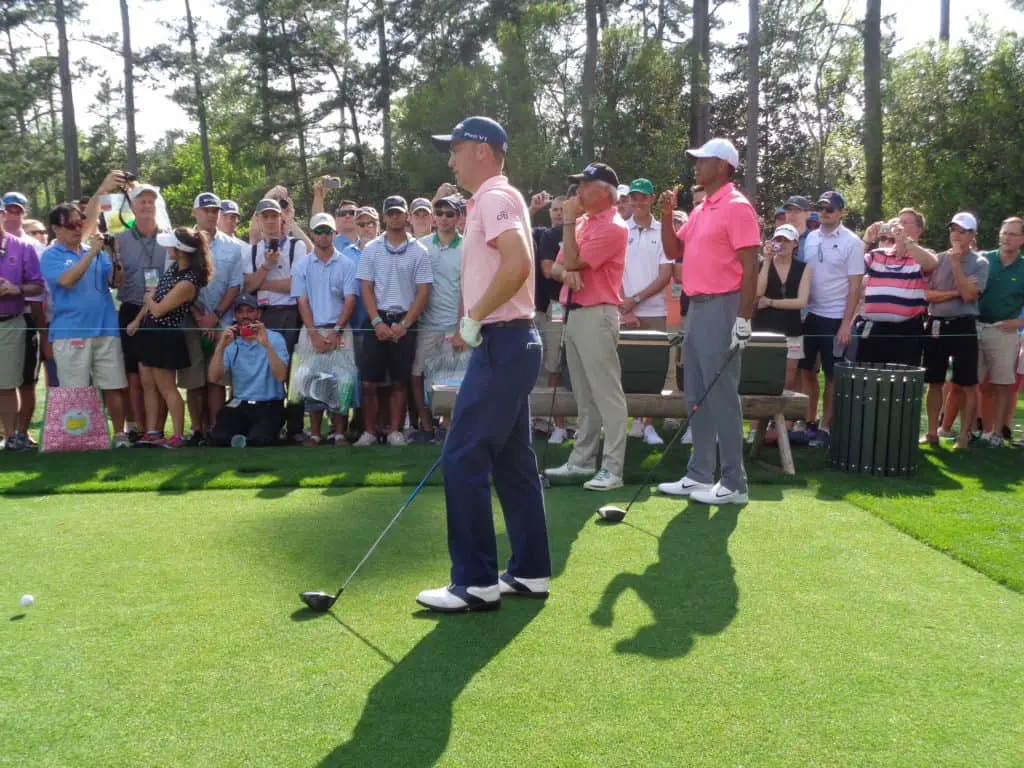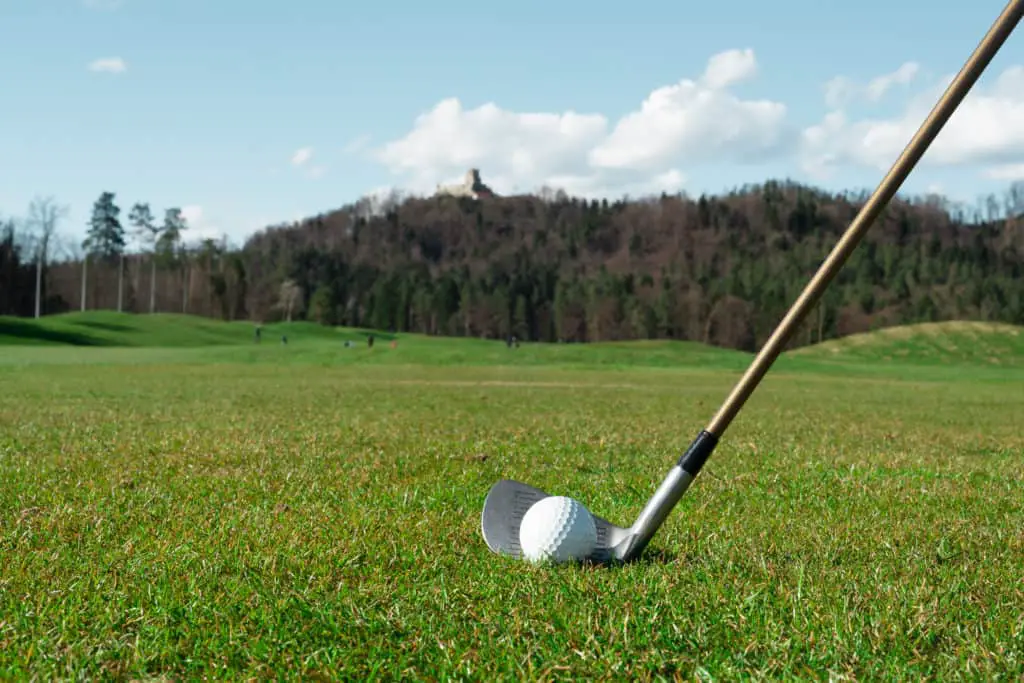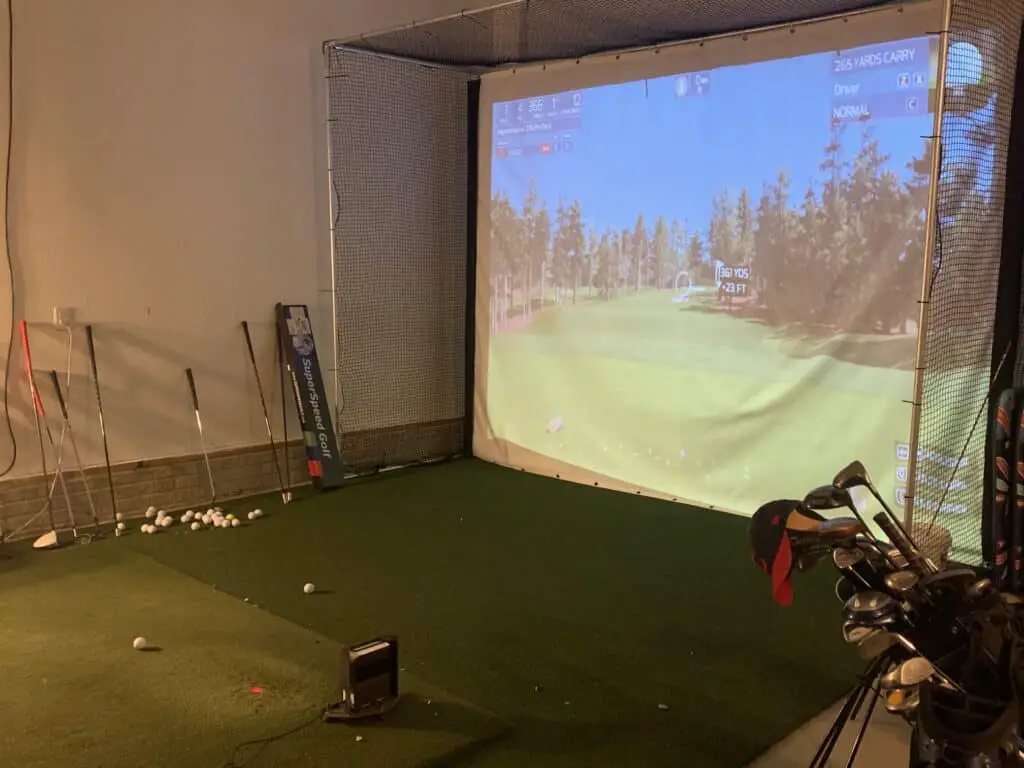Golf can be a difficult game.
We have all had bad days where the game can seem overwhelming.
One thing that can make the game seem frustrating or difficult is when the golfer struggles to hit the ball high enough or far enough.
The good news is that we believe we can help you out by going through several checkpoints and using a process of elimination.
Golf is supposed to be fun and the best golfers can control their trajectory and hit high, low and medium flighted shots depending on the optimal trajectory for the shot on that hole.

Why Do I Hit My Irons So Low?
Typically, the golfer is presenting too little loft at impact or doesn’t have enough swing speed for the loft or the equipment being used by the golfer. Here is a brief checklist:
- Poor setup
- Not enough loft at impact
- Not enough speed
- Not enough compression
- Poor low point control
Below, I will dive into each of the 5 checklist items below and provide a solution or a drill for each issue.
Issue #1: Poor Setup
There are two potential issues with the setup that can result in too low of a ball flight. The first issue is if the golfer has the ball too far back in the stance. The further the ball is back in the stance, the less loft will be presented at impact. As a result the ball will start lower and stay low.
The ideally ball position ranges from just off the front heel to the middle of the stance. For the longer irons the ball will be further up in the stance, for wedges the ball will be more towards the middle of the stance.
The second setup issue has to do with the clubface at setup. If you pre-set the iron to be delofted and facing more towards the ground, you are setting less loft before you even get to impact. The club has a natural loft in it, make sure you are setting up properly.
Solution #1: Set up properly
Go ahead and set up your smartphone from a side view and check the location of your ball positions and the angle of the clubface at setup. Make sure the ball is in the ideal location (not too far back) and that the clubface is no de-lofted at setup. Check this on a regular basis to make sure you are returning to the basics and starting the shot off right by setting up correctly.
Issue #2: Not Enough Loft At Impact
This is a result of a poor setup (see above) or if you are over pushing your hand forward through impact and dragging the handle and the clubface through the hitting zone. Oftentimes, many amateurs chase lag and try to hold off the clubhead release, resulting in low loft at impact and oftentimes a poorly struck shot.
Solution #2: Release the Clubhead
Check your intention before you hit the ball. Have you been chasing lag lately and have started to drag the clubhead through the hitting zone. Go ahead and video your swing once again and see what you are doing with your hands.
If this is the case, have a feel that you are throwing the club down the fairway and let the hands release through the shot. This can help add some loft at impact and keep you from striking the ball poorly.

Issue #3: Not Enough Speed
Many amateur golfers lack swing speed and can get stuck trying to hit a 3, 4 or 5 iron and then struggle to get the ball high enough. If your driver swing speed is 95 or below, it might be time to switch out the 3, 4 and 5 iron for hybrids. The lower your swing speed, the more difficult to launch a ball high enough with clubs such as long irons.
Solution #3: Train for Speed/Swing out Your Clubs
Golfers pretty much have two solutions to hit problem if they are struggling with the height of their shots. #1 Train for speed or #2 swap out the long irons for hybrids.
If you are going to train for speed, I would highly recommend the SuperSpeed Training System.
Gone are the days of simply being content with the distance you currently hit your golf ball. Many older golfers have proven over the past several years that an increase in swing speed is possible.
There are training systems to help you get your game to the next level and distance is arguably the fastest way to make this happen!
My number one recommendation is to check out SuperSpeed Golf and their protocols to help you find a safe way to increase your swing speed.
I spent many years wondering how I can increase my swing speed. When I was playing junior golf, we weren’t fortunate enough to have some of the training aids and knowledge that is now available. Smart people have studied the golf swing and have created training aids and protocols to help all golfers increase their distance!
At around the same time, the statistics from the PGA Tour have become more clear and the importance of speed is acknowledged by many to be a key to being the best on the PGA Tour.
Within the past several years, there have been several products hit the market to make speed gains possible. While many people for many years waited for the latest driver to come out to gain an additional 5-10 yards, you can now do this even with your current clubs.
Did you know that with the SuperSpeed Training System you can gain 5-8% increase in swing speed as early as the first training session? This would allow you to gain somewhere between 10 and 30 yards depending on your current swing speed.
The SuperSpeed Training System is based on three different swing speed sticks all weighing at different weights. There is a green club that is 10% lighter than the average driver, the blue club which is 5% lighter and the red club which is actually 5% heavier!
Following their prescribed protocols the golfer completes the training every other day. The total time to complete most of their protocols is between 10-15 minutes. Most people can find the time to make this happen. The golfer will also need a swing radar to measure their progress.
The science behind the SuperSpeed Training System is based on overspeed training. Overspeed training has been around for several decades now and has been used by olympic athletics in the sport of Track and Field.
The science behind this overspeed training is based on the premise that your brain will only allow your body to move as fast as it feels it can stop safely! So, you get to work and swing the clubs as fast as possible, retraining your brain to allow you to swing your driver faster.
For more permanent results, the golfer should continue these training protocols for several months. The initial 5-8% is great and can become more permanent with the right length of training. The golfer can expect to continue to break down barriers every several months at a 1-2% increase.
My own experience has been an increase of 7-10 miles per hour on average from between 98-101 all the way up to 106-109. My goal is to hit the PGA Tour average of 113 mph in the coming months. I will continue to train every other day and watch in amazement as I am hitting drivers longer now than ever before!
Phil Mickelson (a senior golfer now) has been known to increase his swing speed in the past year or so and is close to 120 miles per hour in his swing speed. There are potential results for golfers of all ability levels and age!
Check the current price on SuperSpeed Golf System, here!
| Original Swing Speed | After 4-6 Weeks | New Carry Distance | Total Distance |
| 95 | 102 | 245 | 265 |
| 100 | 108 | 259 | 279 |
| 105 | 113 | 271 | 291 |
| 110 | 118 | 283 | 303 |

Issue #4: Not Enough Compression
This one can be difficult to measure or see with video, but the golfer can feel compression when an iron is struck solid. Too often the cause of a lack of compression is trying to hit the ball in the air. As a result, the golfer throws loft at the shot, hits the shot slightly on the upswing and never compresses the ball.
Solution #4: Practice With Your Wedge
Pull out your pitching wedge or sand wedge and work on taking a divot on the target side of the hole. You want the club moving slightly down at impact and then through the shot. This doesn’t mean chopping the ball, but allowing the club to work down and through the shot.

Issue #5: Poor Low Point Control
The golfer who one time hits well behind the golf ball and then the next time tops the ball will struggle to have a consistent ball flight which may result in irons flying too low. The best golfers are able to strike the ball solid, present the right loft and hit the optimum ball flight. Controlling the low point of the golf swing is essential to taking your game to the next level.
Solution #5: Low Point Control Drill
The Drill: The Low Point Control Drill
- Take some yard paint and pant a 1-2 yard long line.
- Setup with 55% of your weight on your front side.
- Try to hit the target side of the line and see how many times out of 10 you can do this successfully!
- Repeat this drill every day for a month, tracking your progress and your ability to to this successfully in trials of ten.
- You may need to start with half swing and progress to full swings.
If you are struggling, put more weight forward and work on keeping your head still to help control the low point in the swing.
Other Iron Related Posts:
- How far should you hit an 8 iron?
- Why do my irons go right?
- Why do my irons go left?
- How to hit irons pure?
My Secret To Golf Improvement
Let’s face it, in order to get really good at golf, we must practice frequently. About three years ago, I made the leap and invested in a golf simulator build for my garage. I went with a SkyTrak Launch Monitor and the TGC software and can now play over 100,000 courses including Augusta, Pebble Beach, Bethpage Black, Whistling Straits. St. Andrews and many other of the top 100 courses in the world.
This golf simulator setup, which is more affordable that you might imagine, has been a game changer. I can now play golf everyday of the year regardless of rain, snow, cold weather or time of day. I can practice or play rounds of golf. I can stand in the 11th fairway at Augusta and with the auto-rewind feature I am able to practice my approach shots from various differences.
It is worth checking out through Rain or Shine Golf as they offer some incredible packages along with financing offers that are difficult to beat.
Some direct links to Rain or Shine Golf for pricing and financing:

Take Action – What You Can Do Today to Get Better
What does this mean for you? I believe in the following recipe to get better:
1 – Improve your motion in the golf swing by identifying a golf instructor. Here are some options:
Here is a list of golf instructors that we have reviewed:
2 – Train to swing faster and improve your swing speed. Here are some options:
Looking to gain more Speed and Distance in your swing. Two Options:
3 – Understand course strategy and work to break through your next barrier. Here is a series on breaking through:
We have provided guides on how to break 100, 90, 80 and 70. Check out more below, if interested.
4 – Practice Frequently
Did you know that I build a golf simulator in my garage and have played over 500 rounds of golf on my SkyTrak system? It has been a game changer and one worth checking out. Here are some of my other posts on golf simulators frequently asked questions:
- Is a Golf Simulator Worth It?
- How to Build a Golf Simulator?
- What is the Best Golf Simulator?
- Golf Simulator Accessories?
- How to Build a Golf Simulator for under $7000
- Top 11 Reasons to Buy a SkyTrak
- How to Build a Golf Simulator for Under $1000
- Why Build A Golf Simulator?
- What Space is Needed?
- Can A Golf Simulator Improve My Game?
- How Much Does A Golf Simulator Cost?
- Don’t Forget to Check out our 15 best golf swings of all time.
